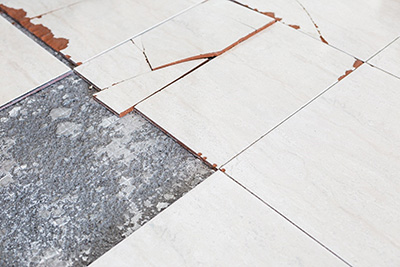Asbestos Floor Tiles: A Complete Guide
Asbestos tiles as well as tile adhesives once contained asbestos and were frequently used in the construction industry from the 1920s until the 1980s. When the tiles are cut, damaged or disturbed, they release asbestos fibers into the air that can cause mesothelioma and other diseases when inhaled. Workers who handled asbestos floor tiles before 1980 are at highest risk of developing disease, but asbestos tiles can still pose a danger today to homeowners, renovators and other professionals. Learn more about what asbestos tile looks like and how to safely work with and handle it.
Use of Asbestos Tiles

Asbestos tile floors were used in both residential homes and commercial buildings throughout much of the 20th century. They were manufactured as either vinyl tiles, including sheet vinyl, or asphalt tiles, which are typically a darker color. Asbestos made the tiles heat-resistant and extremely durable, and they were widely used by builders all over the U.S.
In 1980, the National Institute for Occupational Safety and Health (NIOSH) officially declared that asbestos is linked to disease, including cancer. While a 1989 effort by the Environmental Protection Agency to ban asbestos was overturned, its use in building materials fell out of favor as its dangers became more well-known and asbestos victims began to sue companies that produced them.
Still, millions of homes built before 1980 contain asbestos tiles, and even some built after, as many asbestos products remained on the shelves to be sold even after they were no longer produced.
What Does Asbestos Tile Look Like?
Asbestos was used in many different types of tiles and other floor coverings, so it’s difficult to tell whether tiles contain it by appearance alone. Here are a few other things to consider when you’re trying to determine if you have an asbestos tile floor:
- Installation year: If your tile floor was installed before 1980, it’s safest to assume it contains asbestos. If it was installed before 1960, there’s an even higher chance.
- Adhesive type: A black-colored mastic adhesive was often used to stick tile to the floor or walls—and it often contained asbestos.
- Size: Many asbestos floor tiles were 9-inch by 9-inch squares. These tiles were also made in 12-inch and 18-inch squares, so size alone isn’t an indicator of asbestos.
- Location: Because they were fire- and heat-resistant and very durable, asbestos tiles were often used in the kitchen and other high-traffic areas, like entryways.
- Manufacturer: Many asbestos companies have published lists of tiles they produced that contained asbestos. Tiles aren’t labeled, however, so you’d need to find out the manufacturer from the previous owner or from records.
The only way to know for sure if your home has asbestos floor tiles is to test a sample. It’s best to call in a professional to do this, although there are at-home kits you can order.
Health Risks of Asbestos Floor Tiles
When asbestos tiles are disturbed or damaged, they release microscopic fibers that can be inhaled, then lodge in the lungs. There, they cause scarring, inflammation and a host of asbestos-related diseases, including mesothelioma, lung cancer and asbestosis.
The tiles don’t release asbestos unless they’re broken, sanded, sawed, drilled or otherwise disturbed, so tradespeople who work with them—or have in the past—are at the highest risk. The most at-risk occupations are:
- Building inspectors
- Carpenters
- Electricians
- Firefighters
- Maintenance workers
- Tile and flooring installers
- Tile makers
As long as the tiles aren’t damaged, the health risks are minimal. However, one study did find that abrasion, for example from dragging furniture across the floor, could release fibers from asbestos floor tiles. Homeowners doing renovations are also at risk.
Managing Asbestos Floor Tiles
If you’re thinking about replacing floor tile that was installed more than a few decades ago, the first thing to do is to have it tested. If it does contain asbestos, you’ll need to call in the professionals. You’ll have two options for how to proceed:
- Cover it: It’s generally recommended not to disturb asbestos floor tiles. Instead of replacing your flooring, you can seal, prime and paint over the asbestos tiles. You can also cover them up with laminate, ceramic or even new, asbestos-free vinyl tiles.
- Remove it: If you want to remove the floor tiles and replace them, hire a contractor who is experienced with asbestos removal. Not only will they follow safety procedures, but they can also give you advice as well, like shutting off your HVAC to prevent spreading through the air ducts.
Also, if you know for sure that your home has asbestos tiles and you’re selling it, let your real estate agent know. They can tell potential buyers and save them hassle—and potential asbestos inhalation—if they want to renovate down the line.
If You’ve Been Exposed to Asbestos
The Occupational Safety and Health Administration (OSHA) released its first rules about asbestos exposure on the job in 1971. The current regulations include rules for measuring asbestos levels, providing protective gear, using wetting agents to minimize release into the air and more. However, many workers were exposed to asbestos in the construction industry before 1980, and exposure does still happen today.
If you worked with asbestos floor tiles or other construction materials and were diagnosed with mesothelioma, you may be entitled to compensation. The law firm of Early, Lucarelli, Sweeney and Meisenkothen has decades of experience fighting for mesothelioma victims.
We’re happy to answer your questions and provide a free case evaluation. Just fill out this form on our website to speak with one of our mesothelioma specialists.
FAQs
Are Asbestos Floor Tiles Dangerous?
Asbestos tiles can be dangerous if they’re damaged or disturbed. If they release asbestos into the air and you breathe it in, it can cause diseases. This makes it the most dangerous for people working in construction and other building trades. However, it can also be dangerous for homeowners doing renovations.
How Can I Recognize Asbestos Floor Tiles?
It’s hard to recognize asbestos tiles by sight alone. The material was used for decades in many different floor tile styles and colors. One thing to look for is a black adhesive underneath the tile, which is likely to contain asbestos. However, the best thing to do is to assume that any tile installed before 1980 contains asbestos, and have it professionally tested before disturbing it.
What Health Issues Can Asbestos Floor Tiles Cause?
Asbestos has been linked to mesothelioma, lung cancer and asbestosis, as well as ovarian and laryngeal cancer. Any products containing asbestos, including floor tiles, can cause these health issues if they release fibers into the air.
Is it Safe to Remove Asbestos Floor Tiles on My Own?
No—and in some areas, you’re not legally allowed to remove asbestos yourself. Even if you are, it presents serious hazards to your health if it’s inhaled, so it’s always recommended that you use a professional contractor that’s experienced with asbestos removal.
Request a Free Case Evaluation
Request a free case evaluation now if you or someone you love has been diagnosed with mesothelioma. The evaluation will cost you nothing. Our lawyers will travel to visit you at your convenience or conference call with you over the phone. We understand how difficult a time this is for you and will assist in any way that we can. You can also call us toll-free at 1-800-336-0086 at any time.




